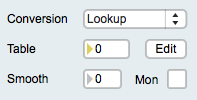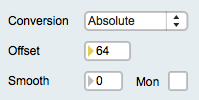EditorX-75 Sensor Input Analog Sensors
Analog Sensors
For analog sensors the following conversion methods are available:
- Thru
- Lookup table
- Absolute value
- Time duration
- Frequency
- Absolute value + BPM
Each method also includes a way to smooth the sensor values and/or monitor them after the above methods and smoothing (if enabled) have been applied but before processing them further. The smoothing applies an exponential moving average filter to the sensor values. A smooth value of zero disables smoothing. Clicking the Mon button enables/disables the monitor. Turn off the monitor if you don't need it to keep the number of MIDI bytes that the digitizer sends to a minimum. A quick-and-dirty way to monitor the sensor value before any processing has been applied, is to make use of a normally unwanted effect, ie. cross-talk. Disconnect all sensors except the sensor of interest and turn on an unused input adjacent to the sensor input of interest. Since this input is "open", ie. not connected to any sensor, it will pickup signals from any other sensor input. The preferred, more reliable way is to physically connect the sensor of interest to an adjacent input, eg. by attaching wires onto the pins of the sensor, adding pins to these wires and plugging these pins into an adjacent input.
Please refer to the FUNCTION command for more information about the above processing methods than provided here.
Thru
The thru function does not convert the sensor value but simply passes on the sensor value, while allows for a smoothing filter to be applied before processing the value. See also the THRU function.
Lookup table
A lookup table takes the sensor value as the index for a table and then outputs the value stored at that index. This method is useful for linearizing the response curve of a sensor, such as the ReachClose, ReachFar and all Touch sensors. See also the LOOKUP function.
Absolute value
The absolute value method subtracts an offset value of the sensor value and if the result is negative, changes the sign of the value so that the output is always positive.This method is useful for sensors whose value at rest, ie. when the sensor is not stimulated, is not zero but varies around a value, such as the BendMicro/Mini/Short, BioVolt and GForce3D. See also the ABSOLUTE function.
Time duration
The time duration method requires that at least the Peak (or Dip) method is enabled in the Processing section. If only the Peak (or Dip) method is enabled, the number of milliseconds between a peak (or dip) and the following peak (or dip) are counted. If Peak (or Dip) End notification is enabled, the number of milliseconds between a peak and its end (ie. the time the value drops below the threshold set for peak detection, ie. the Min value, or Max value in the case of Dip detection, in the Range slider) are counted. If the Constant method is selected the number of milliseconds between the crossings of the threshold are counted. The range of the time duration is 1 - 16383 ms. The time duration unit can be set separately, and setting it to 1 means the time duration is output in milliseconds, setting it to 100 means the time duration is output in 10ths of a second. This method has many applications, such as measuring the time between taps on a Touch sensor, the time a hand was held over a ReachClose sensor or the time between two activations of a MoveOn sensor. See also the TIME function.
Frequency
The frequency method operates like the time duration method but outputs the frequency instead of the time duration. The frequency unit can be set separately, and setting it to 1 means the frequency is output in Hertz (Hz), setting to 60 means the frequency is output as beats per minute (BPM). This method has many applications, such as measuring the BPM of taps on a Touch sensor, or the frequency of breaking a SeeLaser-Red beam pointed at a Flash sensor. See also the FREQUENCY function.
Absolute value + BPM
The "Absolute value + BPM" method combines the absolute method with the frequency method. See the Frequency and Time duration methods for more information. This method is useful for capturing beats per minute (BPM) when using a BioVolt as a heartbeat sensor. See also the ABS-BPM function.






